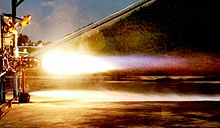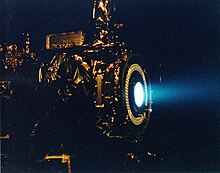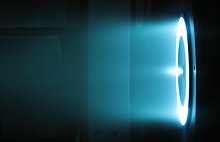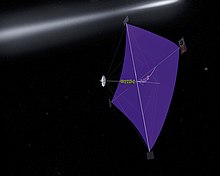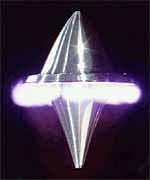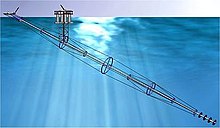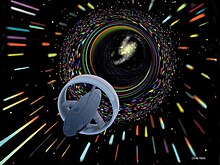From Wikipedia, the free encyclopedia
Interstellar space travel is manned or unmanned travel between stars. Interstellar travel is much more difficult than interplanetary travel: the distances between the planets in the Solar System are typically measured in standard astronomical units (AU)—whereas the distances between stars are typically hundreds of thousands of AU, and usually expressed in light-years. Because of the vastness of those distances, interstellar travel would require either great speed (some percentage of the speed of light) or huge travel time (lasting from decades to millennia).
The required speeds for interstellar travel in a human lifespan are far beyond what current methods of spacecraft propulsion can provide. The energy required to propel a spacecraft to these speeds, regardless of the propulsion system used, is enormous by today's standards of energy production. At these speeds, collisions by the spacecraft with interstellar dust and gas can produce very dangerous effects both to any passengers and the spacecraft itself.
A number of widely differing strategies have been proposed to deal with these problems, ranging from giant arks that would carry entire societies and ecosystems very slowly, to microscopic space probes. Many different propulsion systems have been proposed to give spacecraft the required speeds: these range from different forms of nuclear propulsion, to beamed energy methods that would require megascale engineering projects, to methods based on speculative physics.
For both unmanned and manned interstellar travel, considerable technological and economic challenges would need to be met. Even the most optimistic views about interstellar travel are that it might happen decades in the future due to the exponential advances in technology; the more common view is that it is a century or more away.
Challenges
Interstellar distances
The basic challenge facing interstellar travel is the immense distances between the stars.Astronomical distances are measured using different units of length, depending on the scale of the distances involved. Between the planets in the Solar System they are often measured in astronomical units (AU), defined as the average distance between the Sun and Earth, some 150 million kilometers (93 million miles). Venus, the closest other planet to Earth is (at closest approach) 0.28 AU away. Neptune, the farthest planet from the Sun, is 29.8 AU away. Voyager 1, the farthest man-made object from Earth, is 130.83 AU away.
The closest known star Proxima Centauri, however, is some 268,332 AU away, or 9000 times farther away than even the farthest planet in the Solar System.
| Object | A.U. | light time |
|---|---|---|
| The Moon | 0.0026 | 1.3 seconds |
| Venus (nearest planet) | 0.28 | 2.41 minutes |
| Neptune (farthest planet) | 29.8 | 4.1 hours |
| Voyager 1 | 130.83 | 18.1 hours |
| Proxima Centauri (nearest star) | 268,332 | 4.24 years |
Because of this, distances between stars are usually expressed in light-years, defined as the distance that a ray of light travels in a year. Light in a vacuum travels around 300,000 kilometers (186,000 miles) per second, so this is some 9.46 trillion kilometers (5.87 trillion miles) or 63,241 AU. Proxima Centauri is 4.243 light-years away.
Another way of understanding the vastness of interstellar distances is by scaling: one of the closest stars to the Sun, Alpha Centauri A (a Sun-like star), can be pictured by scaling down the Earth–Sun distance to one meter (~3.3 ft). On this scale, the distance to Alpha Centauri A would be 271 kilometers (169 miles).
The fastest outward-bound spacecraft yet sent, Voyager 1, has covered 1/600th of a light-year in 30 years and is currently moving at 1/18,000th the speed of light. At this rate, a journey to Proxima Centauri would take 80,000 years.[1]
Some combination of great speed and long travel time are required. The time required by propulsion methods based on currently known physical principles would require years to millennia.
Required energy
A significant factor contributing to the difficulty is the energy that must be supplied to obtain a reasonable travel time. A lower bound for the required energy is the kinetic energy K = 1⁄2 mv2 where m is the final mass. If deceleration on arrival is desired and cannot be achieved by any means other than the engines of the ship, then the lower bound for the required energy is doubled to mv2.The velocity for a manned round trip of a few decades to even the nearest star is several thousand times greater than those of present space vehicles. This means that due to the v2 term in the kinetic energy formula, millions of times as much energy is required. Accelerating one ton to one-tenth of the speed of light requires at least 450 PJ or 4.5 ×1017 J or 125 terawatt-hours (world energy consumption 2008 was 143,851 terawatt-hours), without factoring in efficiency of the propulsion mechanism. This energy has to be generated on-board from stored fuel, harvested from the interstellar medium, or projected over immense distances.
Manned missions
The mass of any craft capable of carrying humans would inevitably be substantially larger than that necessary for an unmanned interstellar probe. For instance, the first space probe, Sputnik 1, had a payload of 83.6 kg, whereas the first spacecraft carrying a living passenger (the dog Laika), Sputnik 2, had a payload six times that at 508.3 kg. This underestimates the difference in the case of interstellar missions, given the vastly greater travel times involved and the resulting necessity of a closed-cycle life support system. As technology continues to advance, combined with the aggregate risks and support requirements of manned interstellar travel, the first interstellar missions are unlikely to carry life forms.A manned craft will require more time to reach its top speed as humans have limited tolerance to acceleration.
Interstellar medium
A major issue with traveling at extremely high speeds is that interstellar dust and gas may cause considerable damage to the craft, due to the high relative speeds and large kinetic energies involved. Various shielding methods to mitigate this problem have been proposed.[2] Larger objects (such as macroscopic dust grains) are far less common, but would be much more destructive. The risks of impacting such objects, and methods of mitigating these risks, have been discussed in the literature, but many unknowns remain.[3]Travel time
An interstellar ship would face manifold hazards found in interplanetary travel, including vacuum, radiation, weightlessness, and micrometeoroids. Even the minimum multi-year travel times to the nearest stars are beyond current manned space mission design experience.The habitual illumination energy requirement for each person is estimated to be 12 kilowatts.[4][5] Other long-term energy requirements are still being investigated.[6]
More speculative approaches to interstellar travel offer the possibility of circumventing these difficulties. Special relativity offers the possibility of shortening the travel time through relativistic time dilation: if a starship could reach velocities approaching the speed of light, the journey time as experienced by the traveler would be greatly reduced (see time dilation section). General relativity offers the theoretical possibility that faster-than-light travel could greatly shorten travel times, both for the traveler and those on Earth (see Faster-than-light travel section).
Wait calculation
It has been argued that an interstellar mission that cannot be completed within 50 years should not be started at all. Instead, assuming that a civilization is still on an increasing curve of propulsion system velocity, not yet having reached the limit, the resources should be invested in designing a better propulsion system. This is because a slow spacecraft would probably be passed by another mission sent later with more-advanced propulsion (the incessant obsolescence postulate).[7] On the other hand, Andrew Kennedy has shown that if one calculates the journey time to a given destination as the rate of travel speed derived from growth (even exponential growth) increases, there is a clear minimum in the total time to that destination from now (see wait calculation).[8] Voyages undertaken before the minimum will be overtaken by those who leave at the minimum, whereas those who leave after the minimum will never overtake those who left at the minimum.One argument against the stance of delaying a start until reaching fast propulsion system velocity is that the various other non-technical problems that are specific to long-distance travel at considerably higher speed (such as interstellar particle impact, possible dramatic shortening of average human life span during extended space residence, etc.) may remain obstacles that take much longer time to resolve than the propulsion issue alone, assuming that they can even be solved eventually at all. A case can therefore be made for starting a mission without delay, based on the concept of an achievable and dedicated but relatively slow interstellar mission using the current technological state-of-the-art and at relatively low cost, rather than banking on being able to solve all problems associated with a faster mission without having a reliable time frame for achievability of such.
Communications
The round-trip delay time is the minimum time between an observation by the probe and the moment the probe can receive instructions from Earth reacting to the observation. Given that information can travel no faster than the speed of light, this is for the Voyager 1 about 36 hours, and near Proxima Centauri it would be 8 years. Faster reaction would have to be programmed to be carried out automatically. Of course, in the case of a manned flight the crew can respond immediately to their observations. However, the round-trip delay time makes them not only extremely distant from, but, in terms of communication, also extremely isolated from Earth (analogous to how past long distance explorers were similarly isolated before the invention of the electrical telegraph).Interstellar communication is still problematic – even if a probe could reach the nearest star, its ability to communicate back to Earth would be difficult given the extreme distance. See Interstellar communication.
Prime targets for interstellar travel
There are 59 known stellar systems within 20 light years of the Sun, containing 81 visible stars. The following could be considered prime targets for interstellar missions:[9]| Stellar system | Distance (ly) | Remarks |
|---|---|---|
| Alpha Centauri | 4.3 | Closest system. Three stars (G2, K1, M5). Component A is similar to the Sun (a G2 star). Alpha Centauri B has one confirmed planet.[10] |
| Barnard's Star | 6 | Small, low-luminosity M5 red dwarf. Second closest to Solar System. |
| Sirius | 8.7 | Large, very bright A1 star with a white dwarf companion. |
| Epsilon Eridani | 10.8 | Single K2 star slightly smaller and colder than the Sun. Has two asteroid belts, might have a giant and one much smaller planet,[11] and may possess a Solar-System-type planetary system. |
| Tau Ceti | 11.8 | Single G8 star similar to the Sun. High probability of possessing a Solar-System-type planetary system: current evidence shows 5 planets with potentially two in the habitable zone. |
| Gliese 581 | 20.3 | Multiple planet system. The unconfirmed exoplanet Gliese 581 g and the confirmed exoplanet Gliese 581 d are in the star's habitable zone. |
| Gliese 667C | 22 | A system with at least six planets. A record-breaking three of these planets are super-Earths lying in the zone around the star where liquid water could exist, making them possible candidates for the presence of life.[12] |
| Vega | 25 | At least one planet, and of a suitable age to have evolved primitive life [13] |
Existing and near-term astronomical technology is capable of finding planetary systems around these objects, increasing their potential for exploration.
Proposed methods
Slow, uncrewed probes
Slow interstellar missions based on current and near-future propulsion technologies are associated with trip times starting from about one hundred years to thousands of years. These missions consist of sending a robotic probe to a nearby star for exploration, similar to interplanetary probes such as used in the Voyager program. By taking along no crew, the cost and complexity of the mission is significantly reduced although technology lifetime is still a significant issue next to obtaining a reasonable speed of travel. Proposed concepts include Project Daedalus, Project Icarus and Project Longshot.Fast, uncrewed probes
Nanoprobes
Near-lightspeed nanospacecraft might be possible within the near future built on existing microchip technology with a newly developed nanoscale thruster. Researchers at the University of Michigan are developing thrusters that use nanoparticles as propellant. Their technology is called “nanoparticle field extraction thruster”, or nanoFET. These devices act like small particle accelerators shooting conductive nanoparticles out into space.[14]Michio Kaku, a theoretical physicist, has suggested that clouds of "smart dust" be sent to the stars, which may become possible with advances in nanotechnology. Kaku also notes that a large amount of nanoprobes would need to be sent due to the vulnerability of very small probes to be easily deflected by magnetic fields, micrometeorites and other dangers to ensure the chances that at least one nanoprobe will survive the journey and reach the destination.[15]
Given the light weight of these probes, it would take much less energy to accelerate them. With on board solar cells they could continually accelerate using solar power. One can envision a day when a fleet of millions or even billions of these particles swarm to distant stars at nearly the speed of light and relay signals back to Earth through a vast interstellar communication network.
Slow, manned missions
In crewed missions, the duration of a slow interstellar journey presents a major obstacle and existing concepts deal with this problem in different ways.[16] They can be distinguished by the "state" in which humans are transported on-board of the spacecraft.Generation ships
A generation ship (or world ship) is a type of interstellar ark in which the crew that arrives at the destination is descended from those who started the journey. Generation ships are not currently feasible because of the difficulty of constructing a ship of the enormous required scale and the great biological and sociological problems that life aboard such a ship raises.[17][18][19][20]Suspended animation
Scientists and writers have postulated various techniques for suspended animation. These include human hibernation and cryonic preservation. Although neither is currently practical, they offer the possibility of sleeper ships in which the passengers lie inert for the long duration of the voyage.[21]Extended human lifespan
A variant on this possibility is based on the development of substantial human life extension, such as the "Strategies for Engineered Negligible Senescence" proposed by Dr. Aubrey de Grey. If a ship crew had lifespans of some thousands of years, or had artificial bodies, they could traverse interstellar distances without the need to replace the crew in generations. The psychological effects of such an extended period of travel would potentially still pose a problem.Frozen embryos
A robotic space mission carrying some number of frozen early stage human embryos is another theoretical possibility. This method of space colonization requires, among other things, the development of an artificial uterus, the prior detection of a habitable terrestrial planet, and advances in the field of fully autonomous mobile robots and educational robots that would replace human parents.[22]Mind uploading
A more speculative method of transporting humans to the stars is by using mind uploading or also called brain emulation.[23][24] Frank J. Tipler speculates about the colonization of the universe by starships transporting uploaded astronauts.[25] Hein presents a range of concepts how such missions could be conducted, using more or less speculative technologies, for example self-replicating machines, wormholes, and teleportation.[23][26] One of the major challenges besides mind uploading itself are the means for downloading the uploads into physical entities, which can be biological or artificial or both.Island hopping through interstellar space
Interstellar space is not completely empty; it contains trillions of icy bodies ranging from small asteroids (Oort cloud) to possible rogue planets. There may be ways to take advantage of these resources for a good part of an interstellar trip, slowly hopping from body to body or setting up waystations along the way.[27]Fast missions
If a spaceship could average 10 percent of light speed (and decelerate at the destination, for manned missions), this would be enough to reach Proxima Centauri in forty years. Several propulsion concepts are proposed that might be eventually developed to accomplish this (see section below on propulsion methods), but none of them are ready for near-term (few decades) development at acceptable cost.[citation needed]Time dilation
Assuming one cannot travel faster than light one might conclude that a human can never make a round-trip farther from Earth than 20 light years if the traveler is active between the ages of 20 and 60. A traveler would never be able to reach more than the very few star systems that exist within the limit of 20 light years from Earth. This, however, fails to take into account time dilation. Clocks aboard an interstellar ship would run slower than Earth clocks, so if a ship's engines were powerful enough the ship could reach mostly anywhere in the galaxy and return to Earth within 40 years ship-time. Upon return, there would be a difference between the time elapsed on the astronaut's ship and the time elapsed on Earth. A spaceship could travel to a star 32 light-years away, initially accelerating at a constant 1.03g (i.e. 10.1 m/s2) for 1.32 years (ship time), then stopping its engines and coasting for the next 17.3 years (ship time) at a constant speed, then decelerating again for 1.32 ship-years, and coming to a stop at the destination. After a short visit the astronaut could return to Earth the same way.After the full round-trip, the clocks on board the ship show that 40 years have passed, but according to those on Earth, the ship comes back 76 years after launch.
From the viewpoint of the astronaut, on-board clocks seem to be running normally. The star ahead seems to be approaching at a speed of 0.87 lightyears per ship-year. The universe would appear contracted along the direction of travel to half the size it had when the ship was at rest; the distance between that star and the Sun would seem to be 16 light years as measured by the astronaut.
At higher speeds, the time onboard will run even slower, so the astronaut could travel to the center of the Milky Way (30 kly from Earth) and back in 40 years ship-time. But the speed according to Earth clocks will always be less than 1 lightyear per Earth year, so, when back home, the astronaut will find that 60 thousand years will have passed on Earth.[citation needed]
Constant acceleration

This plot shows a ship capable of 1-gee (10 m/s2 or about 1.0 ly/y2) "felt" or proper-acceleration[28] can go far, except for the problem of accelerating on-board propellant.
Regardless of how it is achieved, if a propulsion system can produce acceleration continuously from departure to destination, then this will be the fastest method of travel. If the propulsion system drives the ship faster and faster for the first half of the journey, then turns around and brakes the craft so that it arrives at the destination at a standstill, this is a constant acceleration journey. If this were performed at nearly 1g, this would have the added advantage of producing artificial "gravity". This is, however, prohibitively expensive with current technology.[29]
From the planetary observer perspective the ship will appear to steadily accelerate but more slowly as it approaches the speed of light. The ship will be close to the speed of light after about a year of accelerating and remain at that speed until it brakes for the end of the journey.
From the ship perspective there will be no top limit on speed – the ship keeps going faster and faster the whole first half. This happens because the ship's time sense slows down – relative to the planetary observer – the more it approaches the speed of light.
The result is an impressively fast journey if you are in the ship.
By transmission
If physical entities could be transmitted as information and reconstructed at a destination, travel at nearly the speed of light would be possible, which for the "travelers" would be instantaneous. However, sending an atom-by-atom description of (say) a human body would be a daunting task. Extracting and sending only a computer brain simulation is a significant part of that problem. "Journey" time would be the light-travel time plus the time needed to encode, send and reconstruct the whole transmission.[30]Propulsion
Rocket concepts
All rocket concepts are limited by the rocket equation, which sets the characteristic velocity available as a function of exhaust velocity and mass ratio, the ratio of initial (M0, including fuel) to final (M1, fuel depleted) mass.Very high specific power, the ratio of thrust to total vehicle mass, is required to reach interstellar targets within sub-century time-frames.[31] Some heat transfer is inevitable and a tremendous heating load must be adequately handled.
Thus, for interstellar rocket concepts of all technologies, a key engineering problem (seldom explicitly discussed) is limiting the heat transfer from the exhaust stream back into the vehicle.[32]
Nuclear fission powered
Ion engine
The NASA spacecraft Dawn was the first to use an ion engine. In an Ion engine, electric power is used to create charged particles of the fuel, usually the gas xenon, and accelerate them to extremely high velocities. The exhaust velocity of conventional rockets is limited by the chemical energy stored in the fuel’s molecular bonds, which limits the thrust to about 5 km/s. Ion engines are in principle limited only by the electrical power available on the spacecraft, but typically the exhaust speed of the charged particles range from 15 km/s to 35 km/s.[33]Fission-electric
Nuclear-electric or plasma engines, operating for long periods at low thrust and powered by fission reactors, have the potential to reach speeds much greater than chemically powered vehicles or nuclear-thermal rockets. Such vehicles probably have the potential to power Solar System exploration with reasonable trip times within the current century. Because of their low-thrust propulsion, they would be limited to off-planet, deep-space operation.Electrically powered spacecraft propulsion powered by a portable power-source, say a nuclear reactor, producing only small accelerations, would take centuries to reach for example 15% of the velocity of light, thus unsuitable for interstellar flight during a single human lifetime.[34]
Fission-fragment
Fission-fragment rockets use nuclear fission to create high-speed jets of fission fragments, which are ejected at speeds of up to 12,000 km/s. With fission, the energy output is approximately 0.1% of the total mass-energy of the reactor fuel and limits the effective exhaust velocity to about 5% of the velocity of light. For maximum velocity, the reaction mass should optimally consist of fission products, the "ash" of the primary energy source, in order that no extra reaction mass need be book-kept in the mass ratio. This is known as a fission-fragment rocket. thermal-propulsion engines such as NERVA produce sufficient thrust, but can only achieve relatively low-velocity exhaust jets, so to accelerate to the desired speed would require an enormous amount of fuel.Nuclear pulse

Based on work in the late 1950s to the early 1960s, it has been technically possible to build spaceships with nuclear pulse propulsion engines, i.e. driven by a series of nuclear explosions. This propulsion system contains the prospect of very high specific impulse (space travel's equivalent of fuel economy) and high specific power.[35]
Project Orion team member, Freeman Dyson, proposed in 1968 an interstellar spacecraft using nuclear pulse propulsion that used pure deuterium fusion detonations with a very high fuel-burnup fraction. He computed an exhaust velocity of 15,000 km/s and a 100,000-tonne space vehicle able to achieve a 20,000 km/s delta-v allowing a flight-time to Alpha Centauri of 130 years.[36] Later studies indicate that the top cruise velocity that can theoretically be achieved by a Teller-Ulam thermonuclear unit powered Orion starship, assuming no fuel is saved for slowing back down, is about 8% to 10% of the speed of light (0.08-0.1c).[37] An atomic (fission) Orion can achieve perhaps 3%-5% of the speed of light. A nuclear pulse drive starship powered by Fusion-antimatter catalyzed nuclear pulse propulsion units would be similarly in the 10% range and pure Matter-antimatter annihilation rockets would be theoretically capable of obtaining a velocity between 50% to 80% of the speed of light. In each case saving fuel for slowing down halves the maximum speed. The concept of using a magnetic sail to decelerate the spacecraft as it approaches its destination has been discussed as an alternative to using propellant, this would allow the ship to travel near the maximum theoretical velocity.[38] Alternative designs utilizing similar principles include Project Longshot, Project Daedalus, and Mini-Mag Orion. The principle of external nuclear pulse propulsion to maximize survivable power has remained common among serious concepts for interstellar flight without external power beaming and for very high-performance interplanetary flight.
In the 1970s the Nuclear Pulse Propulsion concept further was refined by Project Daedalus by use of externally triggered inertial confinement fusion, in this case producing fusion explosions via compressing fusion fuel pellets with high-powered electron beams. Since then, lasers, ion beams, neutral particle beams and hyper-kinetic projectiles have been suggested to produce nuclear pulses for propulsion purposes.[39]
A current impediment to the development of any nuclear-explosion-powered spacecraft is the 1963 Partial Test Ban Treaty, which includes a prohibition on the detonation of any nuclear devices (even non-weapon based) in outer space. This treaty would therefore need to be renegotiated, although a project on the scale of an interstellar mission using currently foreseeable technology would probably require international cooperation on at least the scale of the International Space Station.
Nuclear fusion rockets
Fusion rocket starships, powered by nuclear fusion reactions, should conceivably be able to reach speeds of the order of 10% of that of light, based on energy considerations alone. In theory, a large number of stages could push a vehicle arbitrarily close to the speed of light.[40] These would "burn" such light element fuels as deuterium, tritium, 3He, 11B, and 7Li. Because fusion yields about 0.3–0.9% of the mass of the nuclear fuel as released energy, it is energetically more favorable than fission, which releases <0 .1="" 4="" are="" available="" c.="" correspondingly="" energetically="" exhaust="" fission="" for="" fuel="" higher="" mass-energy.="" maximum="" nbsp="" of="" p="" potentially="" s="" than="" the="" typically="" velocities="">However, the most easily achievable fusion reactions release a large fraction of their energy as high-energy neutrons, which are a significant source of energy loss. Thus, although these concepts seem to offer the best (nearest-term) prospects for travel to the nearest stars within a (long) human lifetime, they still involve massive technological and engineering difficulties, which may turn out to be intractable for decades or centuries.Early studies include Project Daedalus, performed by the British Interplanetary Society in 1973–1978, and Project Longshot, a student project sponsored by NASA and the US Naval Academy, completed in 1988. Another fairly detailed vehicle system, "Discovery II",[41] designed and optimized for crewed Solar System exploration, based on the D3He reaction but using hydrogen as reaction mass, has been described by a team from NASA's Glenn Research Center. It achieves characteristic velocities of >300 km/s with an acceleration of ~1.7•10−3 g, with a ship initial mass of ~1700 metric tons, and payload fraction above 10%. Although these are still far short of the requirements for interstellar travel on human timescales, the study seems to represent a reasonable benchmark towards what may be approachable within several decades, which is not impossibly beyond the current state-of-the-art. Based on the concept's 2.2% burnup fraction it could achieve a pure fusion product exhaust velocity of ~3,000 km/s.
Antimatter rockets
An antimatter rocket would have a far higher energy density and specific impulse than any other proposed class of rocket. If energy resources and efficient production methods are found to make antimatter in the quantities required and store it safely, it would be theoretically possible to reach speeds approaching that of light. Then relativistic time dilation would become more noticeable, thus making time pass at a slower rate for the travelers as perceived by an outside observer, reducing the trip time experienced by human travelers.
Supposing the production and storage of antimatter should become practical, two further problems would present and need to be solved. First, in the annihilation of antimatter, much of the energy is lost in very penetrating high-energy gamma radiation, and especially also in neutrinos, so that substantially less than mc2 would actually be available if the antimatter were simply allowed to annihilate into radiations thermally. Even so, the energy available for propulsion would probably be substantially higher than the ~1% of mc2 yield of nuclear fusion, the next-best rival candidate.
Second, once again heat transfer from exhaust to vehicle seems likely to deposit enormous wasted energy into the ship, considering the large fraction of the energy that goes into penetrating gamma rays. Even assuming biological shielding were provided to protect the passengers, some of the energy would inevitably heat the vehicle, and may thereby prove limiting. This requires consideration for serious proposals if useful accelerations are to be achieved, because the energies involved (e.g. for 0.1g ship acceleration, approaching 0.3 trillion watts per ton of ship mass) are very large.
Rockets with an external energy source
Rockets deriving their power from external sources, such as a laser, could replace their internal energy source with an energy collector, potentially reducing the mass of the ship greatly and allowing much higher travel speeds. Geoffrey A. Landis has proposed for an interstellar probe, with energy supplied by an external laser from a base station powering an Ion thruster.[42]Non-rocket concepts
A problem with all traditional rocket propulsion methods is that the spacecraft would need to carry its fuel with it, thus making it very massive, in accordance with the rocket equation. Some concepts attempt to escape from this problem ([43]):Interstellar ramjets
In 1960, Robert W. Bussard proposed the Bussard ramjet, a fusion rocket in which a huge scoop would collect the diffuse hydrogen in interstellar space, "burn" it on the fly using a proton–proton fusion reaction, and expel it out of the back. Later calculations with more accurate estimates suggest that the thrust generated would be less than the drag caused by any conceivable scoop design. Yet the idea is attractive because the fuel would be collected en route (commensurate with the concept of energy harvesting), so the craft could theoretically accelerate to near the speed of light.Beamed propulsion

This diagram illustrates Robert L. Forward's scheme for slowing down an interstellar light-sail at the destination [44] system.
A light sail or magnetic sail powered by a massive laser or particle accelerator in the home star system could potentially reach even greater speeds than rocket- or pulse propulsion methods, because it would not need to carry its own reaction mass and therefore would only need to accelerate the craft's payload. Robert L. Forward proposed a means for decelerating an interstellar light sail in the destination star system without requiring a laser array to be present in that system. In this scheme, a smaller secondary sail is deployed to the rear of the spacecraft, whereas the large primary sail is detached from the craft to keep moving forward on its own. Light is reflected from the large primary sail to the secondary sail, which is used to decelerate the secondary sail and the spacecraft payload.[45]
A magnetic sail could also decelerate at its destination without depending on carried fuel or a driving beam in the destination system, by interacting with the plasma found in the solar wind of the destination star and the interstellar medium.[46][47]
The following table lists some example concepts using beamed laser propulsion as proposed by the physicist Robert L. Forward:[48]
| Mission | Laser Power | Vehicle Mass | Acceleration | Sail Diameter | Maximum Velocity (% of the speed of light) |
|---|---|---|---|---|---|
| 1. Flyby - Alpha Centauri, 40 years | |||||
| outbound stage | 65 GW | 1 t | 0.036 g | 3.6 km | 11% @ 0.17 ly |
| 2. Rendezvous - Alpha Centauri, 41 years | |||||
| outbound stage | 7,200 GW | 785 t | 0.005 g | 100 km | 21% @ 4.29 ly |
| deceleration stage | 26,000 GW | 71 t | 0.2 g | 30 km | 21% @ 4.29 ly |
| 3. Manned - Epsilon Eridani, 51 years (including 5 years exploring star system) | |||||
| outbound stage | 75,000,000 GW | 78,500 t | 0.3 g | 1000 km | 50% @ 0.4 ly |
| deceleration stage | 21,500,000 GW | 7,850 t | 0.3 g | 320 km | 50% @ 10.4 ly |
| return stage | 710,000 GW | 785 t | 0.3 g | 100 km | 50% @ 10.4 ly |
| deceleration stage | 60,000 GW | 785 t | 0.3 g | 100 km | 50% @ 0.4 ly |
Pre-accelerated fuel
Achieving start-stop interstellar trip times of less than a human lifetime require mass-ratios of between 1,000 and 1,000,000, even for the nearer stars. This could be achieved by multi-staged vehicles on a vast scale.[40]Alternatively large linear accelerators could propel fuel to fission propelled space-vehicles, avoiding the limitations of the Rocket equation.[49]
Speculative methods
Quark matter
Scientist T. Marshall Eubanks thinks that nuggets of condensed quark matter may exist at the centers of some asteroids, created during the Big Bang and each nugget with a mass of 1010 to 1011 kg.[50] If so these could be an enormous source of energy, as the nuggets could be used to generate huge quantities of antimatter—about a million tonnes of antimatter per nugget. This would be enough to propel a spacecraft close to the speed of light.[51]Hawking radiation rockets
In a black hole starship, a parabolic reflector would reflect Hawking radiation from an artificial black hole. In 2009, Louis Crane and Shawn Westmoreland of Kansas State University published a paper investigating the feasibility of this idea. Their conclusion was that it was on the edge of possibility, but that quantum gravity effects that are presently unknown may make it easier or make it impossible.[52][53]Magnetic monopole rockets
If some of the Grand unification models are correct, e.g. 't Hooft–Polyakov, it would be possible to construct a photonic engine that uses no antimatter thanks to the magnetic monopole that hypothetically can catalyze the decay of a proton to a positron and π0-meson:[54][55]A magnetic monopole engine could also work on a once-through scheme such as the Bussard ramjet (see below).
At the same time, most of the modern Grand unification theories such as M-theory predict no magnetic monopoles, which casts doubt on this attractive idea.
Faster-than-light travel

Artist's depiction of a hypothetical Wormhole Induction Propelled Spacecraft, based loosely on the 1994 "warp drive" paper of Miguel Alcubierre. Credit: NASA CD-98-76634 by Les Bossinas.
Even the most serious-minded of these are speculative.
It is also debated whether this is possible, in part, because of causality concerns, because in essence travel faster than light is equivalent to going back in time. Proposed mechanisms for faster-than-light travel within the theory of general relativity require the existence of exotic matter.
Alcubierre drive
According to Einstein's equation of general relativity, spacetime is curved:In physics, the Alcubierre drive is based on an argument that the curvature could take the form of a wave in which a spaceship might be carried in a "bubble". Space would be collapsing at one end of the bubble and expanding at the other end. The motion of the wave would carry a spaceship from one space point to another in less time than light would take through unwarped space. Nevertheless, the spaceship would not be moving faster than light within the bubble. This concept would require the spaceship to incorporate a region of exotic matter, or "negative mass".
Artificial gravity control
Scientist Lance Williams thinks that gravity can be controlled artificially through electromagnetic control.[57]Wormholes
Wormholes are conjectural distortions in spacetime that theorists postulate could connect two arbitrary points in the universe, across an Einstein–Rosen Bridge. It is not known whether wormholes are possible in practice. Although there are solutions to the Einstein equation of general relativity that allow for wormholes, all of the currently known solutions involve some assumption, for example the existence of negative mass, which may be unphysical.[58]However, Cramer et al. argue that such wormholes might have been created in the early universe, stabilized by cosmic string.[59] The general theory of wormholes is discussed by Visser in the book Lorentzian Wormholes.[60]
Designs and studies
Enzmann starship
The Enzmann starship, as detailed by G. Harry Stine in the October 1973 issue of Analog, was a design for a future starship, based on the ideas of Dr. Robert Duncan-Enzmann.[61] The spacecraft itself as proposed used a 12,000,000 ton ball of frozen deuterium to power 12–24 thermonuclear pulse propulsion units.[61] Twice as long as the Empire State Building and assembled in-orbit, the spacecraft was part of a larger project preceded by interstellar probes and telescopic observation of target star systems.[61][62]Project Hyperion
Project Hyperion, one of the projects of Icarus Interstellar.[63]NASA research
NASA has been researching interstellar travel since its formation, translating important foreign language papers and conducting early studies on applying fusion propulsion, in the 1960s, and laser propulsion, in the 1970s, to interstellar travel.The NASA Breakthrough Propulsion Physics Program (terminated in FY 2003 after a 6-year, $1.2-million study, because "No breakthroughs appear imminent.")[64] identified some breakthroughs that are needed for interstellar travel to be possible.[65]
Geoffrey A. Landis of NASA's Glenn Research Center states that a laser-powered interstellar sail ship could possibly be launched within 50 years, using new methods of space travel. "I think that ultimately we're going to do it, it's just a question of when and who," Landis said in an interview. Rockets are too slow to send humans on interstellar missions. Instead, he envisions interstellar craft with extensive sails, propelled by laser light to about one-tenth the speed of light. It would take such a ship about 43 years to reach Alpha Centauri, if it passed through the system. Slowing down to stop at Alpha Centauri could increase the trip to 100 years,[66] whereas a journey without slowing down raises the issue of making sufficiently accurate and useful observations and measurements during a fly-by.
100 Year Starship study
The 100 Year Starship (100YSS) is the name of the overall effort that will, over the next century, work toward achieving interstellar travel. The effort will also go by the moniker 100YSS. The 100 Year Starship study is the name of a one-year project to assess the attributes of and lay the groundwork for an organization that can carry forward the 100 Year Starship vision.Dr. Harold ("Sonny") White[67] from NASA's Johnson Space Center is a member of Icarus Interstellar,[68] the nonprofit foundation whose mission is to realize interstellar flight before the year 2100. At the 2012 meeting of 100YSS, he reported using a laser to try to warp spacetime by 1 part in 10 million with the aim of helping to make interstellar travel possible.[69]
Other designs
- Project Orion, manned interstellar ship (1958–1968).
- Project Daedalus, unmanned interstellar probe (1973–1978).
- Starwisp, unmanned interstellar probe (1985).[70]
- Project Longshot, unmanned interstellar probe (1987–1988).
- Starseed/launcher, fleet of unmanned interstellar probes (1996)
- Project Valkyrie, manned interstellar ship (2009)
- Project Icarus, unmanned interstellar probe (2009–2014).
- Sun-diver, unmanned interstellar probe[71]
Non-profit organizations
A few organisations dedicated to interstellar propulsion research and advocacy for the case exist worldwide. These are still in their infancy, but are already backed up by a membership of a wide variety of scientists, students and professionals.- Icarus Interstellar [68]
- Tau Zero Foundation (USA) [72]
- Initiative for Interstellar Studies (UK) [73]
- Fourth Millennium Foundation (Belgium) [74]
- Space Development Cooperative (Canada) [75]






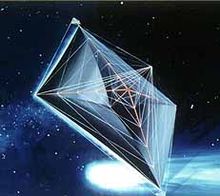
 ). The unit for this value is seconds. Because the weight on Earth of the reaction mass is often unimportant when discussing vehicles in space, specific impulse can also be discussed in terms of impulse per unit mass. This alternate form of specific impulse uses the same units as velocity (e.g. m/s), and in fact it is equal to the effective exhaust velocity of the engine (typically designated
). The unit for this value is seconds. Because the weight on Earth of the reaction mass is often unimportant when discussing vehicles in space, specific impulse can also be discussed in terms of impulse per unit mass. This alternate form of specific impulse uses the same units as velocity (e.g. m/s), and in fact it is equal to the effective exhaust velocity of the engine (typically designated  ).
). ).
).
 ).
). is the
is the 

 is the
is the 

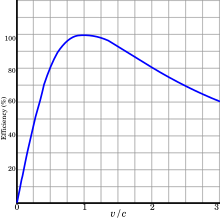

 is useful payload and
is useful payload and  is reaction mass (this corresponds to empty tanks having no mass, etc.). The energy required can simply be computed as
is reaction mass (this corresponds to empty tanks having no mass, etc.). The energy required can simply be computed as


 is the specific energy of the rocket (potential plus kinetic energy) and
is the specific energy of the rocket (potential plus kinetic energy) and  . In the case of using the rocket for deceleration, i.e. expelling reaction mass in the direction of the velocity,
. In the case of using the rocket for deceleration, i.e. expelling reaction mass in the direction of the velocity,  , where for the fuel value also the mass of the oxidizer has to be taken into account. A typical value is
, where for the fuel value also the mass of the oxidizer has to be taken into account. A typical value is  = 4.5 km/s, corresponding to a fuel value of 10.1 MJ/kg. The actual fuel value is higher, but much of the energy is lost as waste heat in the exhaust that the nozzle was unable to extract.
= 4.5 km/s, corresponding to a fuel value of 10.1 MJ/kg. The actual fuel value is higher, but much of the energy is lost as waste heat in the exhaust that the nozzle was unable to extract. is
is
 we have
we have 
 , requiring an energy of
, requiring an energy of .
. or less, the maneuver can not be carried out at all with this engine.
or less, the maneuver can not be carried out at all with this engine.
 is the thrust and
is the thrust and  the acceleration due to it. Thus the theoretically possible thrust per unit power is 2 divided by the specific impulse in m/s. The thrust efficiency is the actual thrust as percentage of this.
the acceleration due to it. Thus the theoretically possible thrust per unit power is 2 divided by the specific impulse in m/s. The thrust efficiency is the actual thrust as percentage of this. we have
we have 


